Vermes
Advanced Member level 4

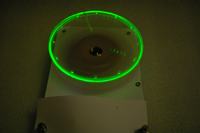
The display of this device consists of two parts: base with engine and rotating part with the glowing ruler (the rotor). The base was made of a hard drive with electronics and engine. The engine is controlled by the electronics of the hard drive, so that you have to apply a double supply (5V and 12V).
Main components of the rotating part are:
- microcontroller AVR Attiny 2313 clocked by internal clock 8MHz
- 9 lighting diodes of brightness 500 mcd
- photodiode sensitive to infrared
- accumulator 3,7V with a capacity of 100 mAh
Due to the use of accumulator, the system is not designed for continuous work. In this version it would have to be charged every day.
Principle of operation:
Displays of this type use the phenomenon of inertia of the human eye. Hand, rotating, flashes in strictly measured locations millionths of a second, giving the impression of continuously flashing point or hand of clock. During each revolution, the rotor photodiode receives the signal form stationary infrared diode. Then the upper part of the display is established. Microcontroller chip measures the time between the signals, thereby indicating the speed of the board (flashing ruler). When the time of a full rotation is already known, the time of rotation by 3 degrees (1/120 circle) is calculated. Then that time is counted down 120 times (so it takes a full turn), each time the system checks whether it is now to light up the appropriate diodes. Lit diodes are turned off after 10 microseconds, they move at this time by 0,28mm.
Numbers:
- full rotation time: 11400 microseconds
- 3 degree rotation time: 11400/120=95 microseconds
- diode lighting time: 10 microseconds
- rotations/second: 87,7
- ruler/hand radius: 5cm
- speed of the furthest diode: 27,5m/s (99,2km/h)
- power consumption by the hand: 5mA
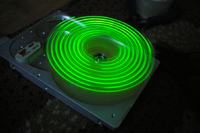
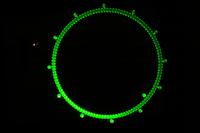
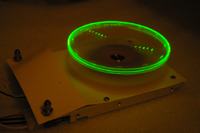
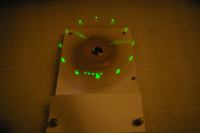

Video:
Link to original thread (useful attachment) - Wyświetlacz widmowy zwykły